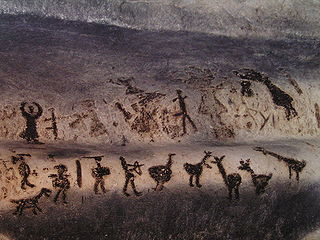Magura (cave)
| Magura
|
||
|---|---|---|
|
Frescoes in the Magura cave |
||
| Location: | near Rabischa , Bulgaria | |
|
Geographic location: |
43 ° 43 '6.4 " N , 22 ° 36' 0.9" E | |
|
|
||
| Lighting: | electric | |
| Overall length: | approx. 2.5 km | |
Magura ( Bulgarian Магура ) is a cave in Bulgaria . It is located in the northwestern part of the Balkan Mountains , near the village of Rabischa, around 17 km from the city of Belogradchik and 35 km south of Vidin . The cave is approx. 2.5 km long and karstified, and it covers an area of 28,600 m². The cave consists of a central gallery in a southeast-northwest direction and three secondary galleries with a length of 200 m and a width of 50 m and a height of up to 20 m.
The cave was first used by humans in the period between 50,000 and at least 36,000 BP, and it must have been Neanderthals at first . Paintings can be seen on some of the walls, the oldest of which date from the Upper Palaeolithic , but mainly depictions from the Neolithic , Copper and Bronze Ages .
A special feature is the oldest European solar calendar from the late Aeolithic or the late Neolithic with 366 days.
In contrast to most caves, in Magura not only inorganic substances were used for the paintings, but also organic, namely fossilized bat guano , which outside of Bulgaria, where this is also documented in the Baylovo cave, only in the Italian Grotta dei Cervi is proven. The gallery where the paintings are located is the highest part of the cave. It is 240 m long and up to 24 m high. It covers an area of 3750 m². The painted wall shows twelve groups of paintings over a length of 105 m, which are separated from each other by unpainted stretches of 5 to 11 m. These represent religious ceremonies, hunting scenes, deities, including dancing men and women, people with masks, a large number of animals, but also symbols such as suns, stars or other signs.
The gallery was open between 2002 and 2007, the cave from 1961. After severe damage to the paintings by moisture and vandalism, the gallery was closed. Magura is one of the 100 national tourist objects in Bulgaria. It and its surroundings have been declared a nature reserve. The drawings have been restored since September 2007 and can still be viewed in guided groups. Sparkling wine is produced in a side gallery.
literature
- Stefanka Ivanova, Maria Gurova, Nikolai Spassov, Latinka Hristova, Nikolay Tzankov, Vasil Popov, Elena Marinova, Jana Makedonska, Victoria Smith, Claudio Ottoni, Mark Lewis: Magura Cave, Bulgaria: A multidisciplinary study of Late Pleistocene human palaeoenvironment in the Balkans , in: Quaternary International (2015) 1–23.
- Violina Ivanova, Iva Tomova, Atanas Kamburov, Anna Tomova, Evgenia Vasileva-Tonkova, Margarita Kambourova: High phylogenetic diversity of bacteria in the area of prehistoric paintings in Magura Cave, Bulgaria , in: Journal of Cave and Karst Studies 75 (2013) 218 -228.
Web links
- The Magura Cave (The Rabisha Cave). bulgariatravel.org
- Magura on showcaves.com
- Photos of the cave
Individual evidence
- ↑ Violina Ivanova, Iva Tomova, Atanas Kamburov, Anna Tomova, Evgenia Vasileva-Tonkova, Margarita Kambourova: High phylogenetic diversity of bacteria in the area of prehistoric paintings in Magura Cave, Bulgaria , in: Journal of Cave and Karst Studies 75 (2013) 218-228, here: p. 219.
- ↑ Penka Maglova, Alexey Stoev, Mina Spasova, Todor Todorov: Bulgarian caves in the historical development of human civilization , in: Proceedings of the 12th EuroSpeleo forum. Ebensee, Austria, August 23rd-26th, 2018 , Speleological Society of Ebensee, Ebensee 2018, pp. 90–94, here: p. 92.
- ↑ a b The Magura Cave. Official Tourism Portal of Bulgaria, accessed on February 23, 2019 .
- ↑ Violina Ivanova, Iva Tomova, Atanas Kamburov, Anna Tomova, Evgenia Vasileva-Tonkova, Margarita Kambourova: High phylogenetic diversity of bacteria in the area of prehistoric paintings in Magura Cave, Bulgaria , in: Journal of Cave and Karst Studies 75 (2013) 218-228, here: p. 218.


